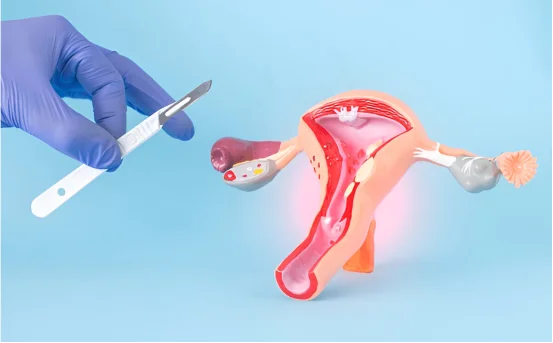The hysteroscopic procedure is a minimally-invasive surgery that allows doctors diagnose and treat problems within the uterus. The hysteroscope is a thin, light-up instrument that is inserted into the uterus through the vagina. Hysteroscopy is a popular method to treat uterine problems, thanks to the advancement of gynecological technology.
Understanding the treatment for hysteroscopic surgery, recovery and outcome of hysteroscopy is important for your peace of mind.
What is hysteroscopic surgery?
The term hysteroscopic surgery is used to describe procedures performed using a hysteroscope. It is used for both diagnostic and surgical purposes.
- Diagnostic Hysteroscopy : Identifies abnormalities such as abnormal bleeding and uterine abnormalities.
- Operative Hysteroscopy : Treats conditions like fibroids, adhesions or polyps with a single treatment.
This procedure is usually performed as an outpatient, which means that no hospitalization is necessary.
Who needs hysteroscopic surgery?
Women who experience:
- Heavy or irregular bleeding during menstruation
- Infertility and repeated miscarriages
- Uterine polyps or fibroids
- Adhesions
- A uterine septum
- Postmenopausal bleeding
- Retained Products of Concept
The uterine cavity can be seen in detail during hysteroscopic surgery, which helps with accurate diagnosis and treatment.
Pre-surgical Preparation
Your doctor may ask you:
- Recommend an ultrasound and pelvic examination.
- Prescribe medication to soften the cervix.
- Fasting is recommended for a couple of hours prior to surgery.
- Consider the options for anesthesia: local, regional or general.
Inform your doctor if you’re taking any medication or if you’re pregnant.
Hysteroscopic Treatments
Different types of treatment may be used during the procedure, depending on your condition:
- Fibroid Removal (Myomectomy):- Useful for removing submucosal uterine fibroids, which grow in the uterine cavity. Reduces heavy bleeding and improves fertility.
- Polypectomy:- This procedure involves removing polyps that may be causing irregular bleeding or infertility.
- Adhesiolysis:- To restore normal uterine functioning, the scar tissue (Asherman Syndrome) in the uterus is removed.
- Endometrial Ablation:- The uterine lining is destroyed to treat heavy menstrual periods in women that do not want to get pregnant.
- Septum Resection:- Removing a congenital septum of the uterus that may interfere with fertility, or even cause miscarriage.
What to expect from ?
- Anesthesia Depending on how complex the surgery is, it may be necessary to use local or general anesthesia.
- Insertion Hysteroscope : A hysteroscope gently passes through the vaginal and cervix to the uterus.
- Uterine distension: Use a sterile liquid gas to expand the uterus and improve visibility.
- Treatment Execution : Tools are inserted into the hysteroscope to remove polyps or scar tissue.
- Completion : The instruments have been removed and the patient has undergone a brief period of observation.
Recovery after Hysteroscopic Surgery
Most women return to their normal routines within 1-2 working days. Post-operative symptoms can include:
- Mild cramping or discomfort
- Vaginal bleeding is a light bleed
- Watery discharges for a couple of days
- Fatigue after anesthesia
Aftercare tips:
- For at least a week, avoid sexual activity, douching or the use of tampons, or follow any advice given by your doctor.
- If needed, take prescribed pain relievers.
- You should follow up with your doctor to discuss the results and continue care.
Benefits of Hysteroscopic surgery
Hysteroscopy has several advantages over traditional surgery.
- Minimally Invasive
- No abdominal incisions
- Quick recovery
- Outpatient procedure
- Reduced risk of infection
- Preservation and preservation of the uterus
This procedure is especially beneficial to women who wish to preserve their fertility, or prefer less invasive methods of surgery.
Complications and Risks
Although considered safe, hysteroscopic surgeries may have minor risks including:
- Uterine perforation
- Infection
- Heavy bleeding
- Reaction to anesthesia
- Fluid overload (rare)
To minimize risk, it is important to select a gynecologist who is qualified and experienced.
When Should You Contact a Physician
Contact your healthcare provider immediately if:
- Heavy bleeding (more that a period).
- Foul-smelling discharge
- Abdominal pain that is severe
- Fever or chills
- Difficulty in urinating
Early treatment can prevent complications.
Conclusion
The hysteroscopic procedure is a breakthrough in gynecology, providing both diagnostic insight and therapeutic relief to many uterine disorders. It is a minimally invasive procedure that offers quick recovery and is a good solution for women with uterine issues such as fibroids, polyps or unexplained fertility.
You can rest assured that if your doctor recommends hysteroscopy it’s a safe, effective procedure that will improve your overall health and reproductive function.























